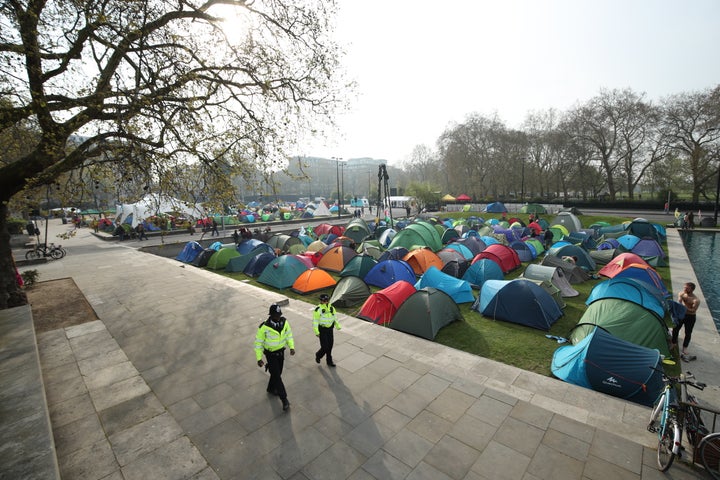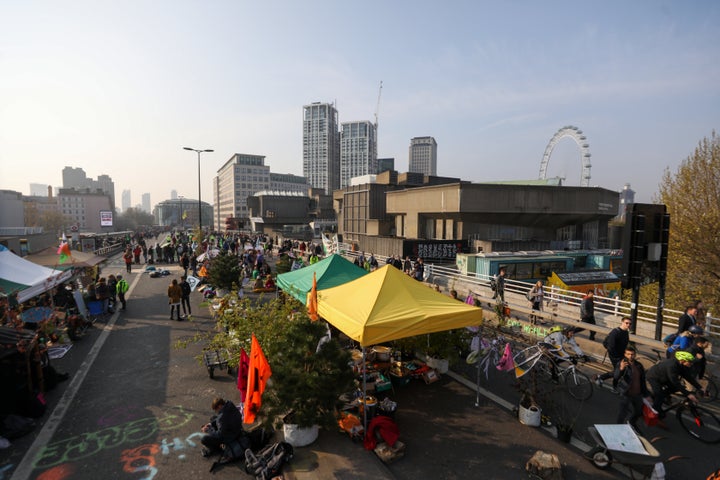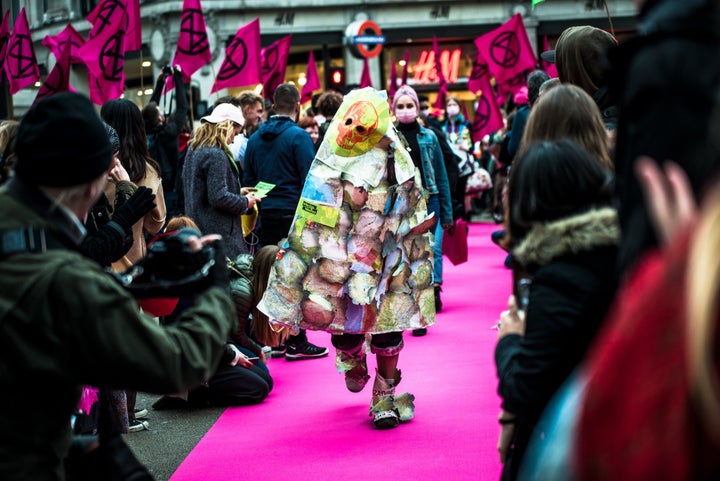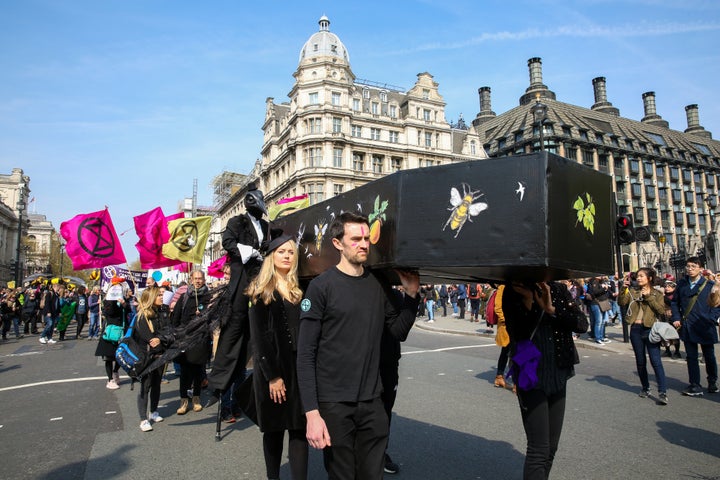It’s a rare occurrence for London’s iconic – and usually very busy – Waterloo Bridge to be devoid of traffic, but this week Extinction Rebellion has managed to achieve just that.
Instead of the usual stream of cars and buses, there is a stage where a poet is currently performing, a food tent where volunteer chefs are cooking up a curry while others wash dishes, a creche area where circus performers are entertaining small children.
There’s even a skate ramp for those feeling energetic.
The result is what feels like a small piece of Glastonbury festival, in the centre of the nation’s capital city. And it’s been like this for three days and counting.
The week’s direct action has been over a year in the works and has involved thousands of people, as well as countless google docs, WhatsApp messages and video conference calls, Robin Boardman, one of the co-founders of XR – as the members call it – told HuffPost UK.
Across the city in Marble Arch, Oxford Circus and Parliament Square, similar set ups and hundreds of protestors can be found causing untold disruption to London’s roaring traffic.
The aim of Extinction Rebellion is to get the government to respond to their demands for tougher action on climate change, including reducing greenhouse gas emissions to net zero by 2025 and creating a citizens’ assembly on climate and ecological justice.
At the time of writing, Scotland Yard confirmed more than 300 protesters have been arrested. Buddhist minister Yanai Postelnik was among around half a dozen protesters detained on Waterloo Bridge on Wednesday afternoon after three police vans pulled up in attempt to clear the road.
Getting arrested is actually the aim for many of the campaigners. They are encouraged to attend one of the training sessions on legal rights being hosted at each of the four sites at regular intervals throughout the day.

Organising such a logistical nightmare has been “knackering”, Boardman says, but it has helped that so many people have been involved. The campaign group has been heavily inspired by Bernie Sanders’ democratic nomination campaign, he says.
“The Sanders campaign was really well organised. What they realised was the strength in the movement comes from asking a big thing of people. It wasn’t about small asks,” he says.
While Hillary Clinton’s campaign asked people to give a few hours a week to make calls, the Sanders campaign asked for a lot more while also recruiting others to do the same, Boardman says.
“They said we want a political revolution, that’s what [Sanders] called it, and we want you to volunteer 35 hours a week and we want you to give your all, or whatever you can to make that happen.”
This demand for a such a huge commitment built a huge volunteer network of people who were incredibly dedicated because it was such a big cause, Boardman says.
Volunteers were being trained up, and then asked to bring in other volunteers who they then trained, and so it went on.
“Through that structure and that system, they were calling and knocking on doors of millions of Americans every day and they reckon if they had had three more weeks before the democratic nomination, they could have spoken to every single person in America through that volunteer network.”
Boardman says a lot the design of the volunteering structure was “pretty much replicated” in Extinction Rebellion and that the climate change group had been advised by members of the Sanders campaign team.
Volunteers join different teams such as transport or catering, and are given autonomy to fulfil the brief as they see fit and recruit more people to help out.
“There is an overarching actions team and they have coordinators for wellbeing and coordinators for stewards and every other detail, and those people who are the coordinators have the decision on how that thing gets done and they are completely empowered. It allows people’s creativity and allowing them to bring their all to it,” Boardman says.

Boardman says it was impossible to know how many people have actually been involved in the action’s organisation because it has grown so rapidly.
“I couldn’t tell you honestly but I do know we have 80,000 people on our mailing list and thousands of people involved in organising.
“In Bristol last week before the rebellion started, there were 200 people at a local meeting, for example. It’s incomparable to Momentum and Greenpeace and other campaigns. It’s really captured a bit of a moment I think,” he says.
Organising something that felt safe and welcoming enough to draw out those who had never protested before, of which many of those interviewed by HuffPost UK earlier in the week fell into the category of, has been crucial.
“Classic activist spaces can be quite exclusive in the ways of organising particularly around civil disobedience or direct action. They use secure channels and only tell people they trust but what has really allowed for the growth of XR has been the principle of openness and respect.
“We are open about all the actions we do. We are open about the fact we are going to have a rebellion on the streets and take those five sites because that’s one of our principles ... we are asking the government to tell the truth so we are going to tell the truth.”

The way the group is funded is also similar to the Sanders campaign as much of the money it has raised has come from smaller donors. It has also been funded by grants from Lush cosmetics and the Guerrilla Foundation, which funds activism.
“The majority has come through small-scale donations which has meant we could do stuff like buy a boat and put it in Oxford Circus,” he says.
Boardman believes hundreds of people are now working for Extinction Rebellion full-time, with around 40-50 full-time workers in the London office.
He says: “Most of them have quit their jobs to do it. There are people who worked in the advertising industry who have quit their jobs to work on this.”
Dr Alison Green, who has been involved from near the beginning of the groups inception, told HuffPost UK that the success of the group is based on it being organised in the ‘holacratic’ structure Boardman described, which means it is decentralised and not organised from the top down.
Green, who heads up the academics partnership team, says that while autonomy has been important, the organisation has developed strong communication between teams to make sure information is passed on.

This has meant the group has been able to mobilise a lot of people. Nonetheless, some of the organisers have worked 24/7 to pull off the protest, she says.
“The planning for April has been in the works for a long time and the organisation has been incredibly impressive. It’s been a really impressive feat of operations.
“There has been a lot of intense planning meetings in the London office ... we have also extensively organised messaging such as WhatsApp but also just picking up the phone and talking.”
On the ground coordinators are in constant contact making sure each site has enough people for them to hold off the police from clearing the areas, as well as finding people to speak to the media.
“People are moving from location to location to the sites that need support and we have been getting minute-by-minute updates on what’s been happening and where people are needed.”
With so many people getting arrested, the group have organised waves of campaigners throughout the week to refresh areas police have been trying to clear. Green also said many are choosing to come straight back after being released while others have seen what is happening on the news and chosen to head down and join in.
WhatsApp is also being used to exchange stories of positive things protestors have done to help keep motivation levels up.
Green says one story shared on Wednesday morning was about an elderly couple who put themselves in front of younger protesters to protect them from being arrested.
Green said of the couple: “They said, we have caused these problems so we will go first.”

